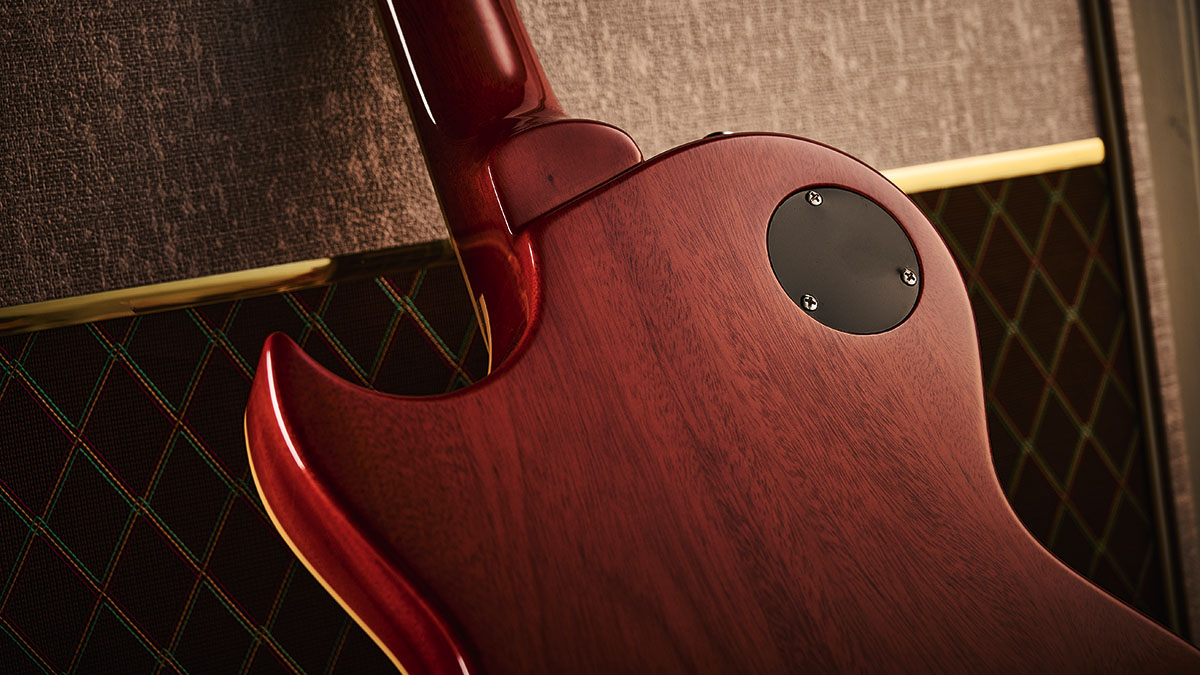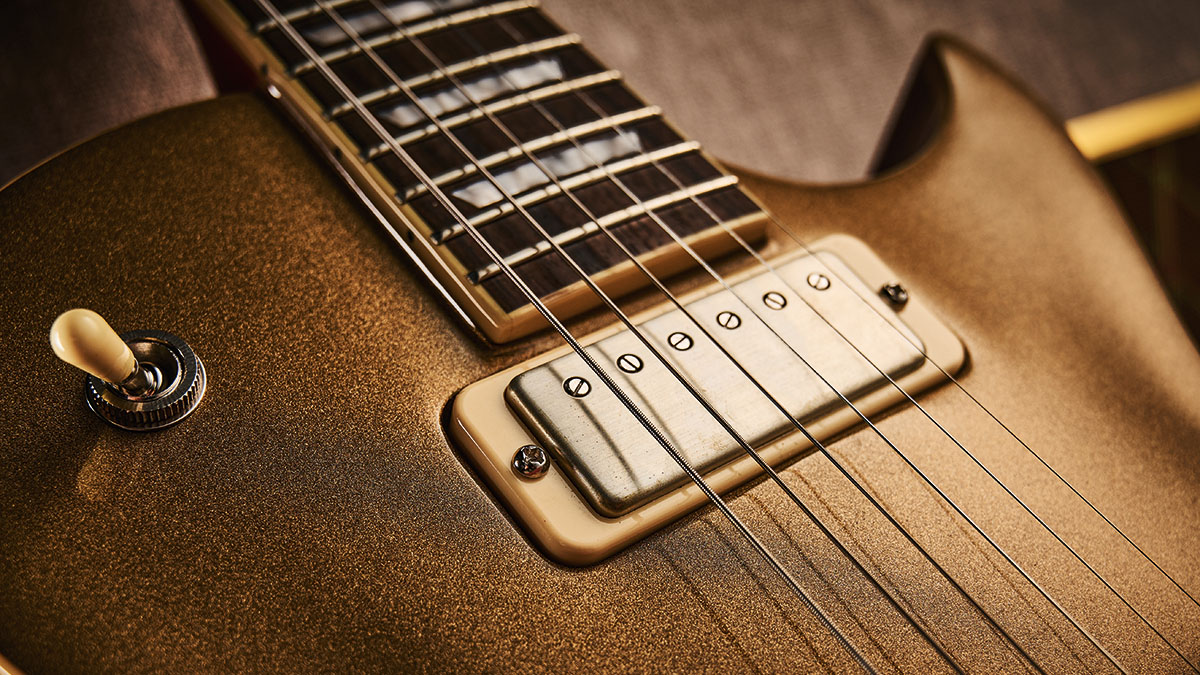Guitar World Verdict
In a world of copycat designs, this is something a little different with a core sound that is pretty impressive.
Pros
- +
Nice build with very detailed features.
- +
Good hardware and pickup choice.
- +
A wide range of mostly good, quite classic sounds.
Cons
- -
The push-push switching might not be useful for everyone.
- -
The Varicoil is far from gradual.
- -
It’s a heavy single-cut.
You can trust Guitar World
In one of those ‘where the heck does time go?’ moments, we realise that next year it will be the 30th anniversary of Fret-King’s launch at the 1994 NAMM Show. In fact, 30 years ago, the original designer, Trev Wilkinson – who sold the brand to JHS in 2007 but still provides the pickups here – was putting his ideas into practice as he prepared for that launch.
Fret-King has had quite a history since then. We’ve seen models made in the UK, Europe, Korea and most recently India where the latest 2023 collection is made, and, from this writer’s perspective at least, relative affordability has always been key to the range, which playfully adapts the classics – the epitome of inspired-by, not copycat design.
Last year, we took a look at one of our favourite Fret-King designs, the Elise, alongside another stalwart, the Country Squire. Now it’s time to reacquaint ourselves with the long-running Eclat, which also introduces a tie-up with UK guitarist Paul Rose.
While its inspiration is obvious, there are plenty of tweaks. Take the elegant curved line from the upper shoulder into the treble cutaway with its thinned horn, for example, and the oh-so-classic headstock that deviates from Gibson outline with a single domed top and that lightly dished indent. That feature is amplified on the body where a concave scoop is cut out in the forearm area of the body, through the maple top and into the mahogany back wood.

To our eyes, that can look a little odd in a sunburst finish, for example, but here the sparkly Goldtop finish – which is exclusive to this signature guitar – almost enhances the curved lines, even though the edge binding probably causes a few headaches in the factory! But the fit and finish are very good overall.
Yes, the actual finish is rather high-gloss poly standard, but you can’t knock the tidy execution, not least where the binding and slight edge of the Goldtop finish is fitted really smartly into the treble cutaway.

While the hardware, not to mention the fingerboard inlays, all shout someone else’s brand, unlike the non-signature Eclat custom where we get two Focusfield mini-humbuckers, here the bridge pickup is a full-size humbucker. Plus, instead of the classic four-control layout, we get three controls with typical twists.
All the latest guitar news, interviews, lessons, reviews, deals and more, direct to your inbox!
The volume closest to the bridge is actually a push-push switched pot that introduces a kill-switch mute when pushed up (we’ll get to that later); the lower control is Wilkinson’s Varicoil, which moves both humbucker pickups from full-humbucking to single coil.
Last but not least, the middle-placed tone control also has a push-push switch that introduces an out-of-phase option when both pickups are selected from the shoulder-placed three-way toggle switch.
Feel & Sounds

Despite the described changes to the recipe, the Eclat remains a chunky single-cut with an overall body depth of 60mm and a weight of 4.74kg (10.43lb); in other words, it’s heavy for the style. Played seated or high on a strap, you do notice the additional comfort that the forearm scoop brings. Obviously, strapped low down and all rock ’n’ roll, it won’t impact on the feel at all.
The neck profile certainly doesn’t let the side down. It’s a good relaxed C that feels like a half-way house between Gibson’s larger ’50s profile and the thinner ’60s SlimTaper, measuring 21.3mm at the 1st fret and 23.3mm by the 12th, with a 44.5mm nut width (although string spacing of only 34.5mm).
There’s little to moan about with the setup or fretwork, not least the incurve to the fingerboard binding. As supplied, the string height was a little low on the bass side for our taste, but that’s easily fixed by the thumbwheel height adjustment for the tune-o-matic-style bridge.

The core humbucking sounds here are very good. We have a soft spot for this pickup combination where the lighter-sounding mini-humbucker is very clean and unmuddy, while the bridge has more thickness and kick.
It’s classic blues/rock, but there’s much more scope here; it’s a very well-balanced set. The tone control is good, too. In that full-off it’s more ‘woman’ tone than muffled tone, while the master volume creates a fast drive.
And while many of us might just enjoy these sounds, the three controls here all have a dual function. Push down on that volume knob and it mutes your sound. You can achieve a degree of staccato effect by very lightly pushing on the knob so it pulls in the signal, but it’s all too easy to latch the switch so you’re back to full-on.

The tone control has the same push switch, but with both pickups selected they’re fully out-of-phase, which produces a very thin and nasally sound with a lower output.
Unlike a guitar with two volumes, you can’t offset the phase to produce that more Peter Green‑like fullness but with just a touch of the nasally out-of-phase character. That said, in humbucker mode and rolling back the tone, it gets pretty close.
Finally, with the Varicoil control fully anti-clockwise, it voices the humbucking mode of each pickup. The idea is as you turn it down, the sound moves to single coil, but in reality there’s a little sweet spot right at the lower end of the travel where you hear the transition.
It’s hardly a gradual sweep, something that’s backed up by our multimeter. But the single-coil voices, the screw coils, are perfectly usable, expanding the guitar’s considerable range.
Verdict
Daring to be different isn’t easy in the cut-and-thrust of today’s lower-priced market. Overall, although it’s far from lightweight, this is a rather good and well-priced single-cut for the quality it presents – it’s a good player and very well detailed in terms of its construction, detail and setup. But the polarising feature remains that forearm scoop, which, while practical for some, may just look too far from classic for most.
Then, while the core sounds here are very good, we’re not sure that the dual functions are quite as useful as they might appear on paper. To be honest, though, wiring changes are simple and the signature artist is happy. All good.
Specs
- PRICE: £899 (approx $999 / inc gigbag)
- ORIGIN: India
- TYPE: Single-cutaway, solidbody electric
- BODY: 2-piece, centre-joined mahogany with carved maple cap
- NECK: 1 piece mahogany, ‘soft C’ profile, glued-in
- SCALE LENGTH: 628mm (24.75”)
- NUT/WIDTH: Graph Tech Tusq/ 44.5mm
- FINGERBOARD: Bound Indian rosewood, trapezoid pearloid inlays, 254mm (10”) radius
- FRETS: 22, medium
- HARDWARE: Tune-o-matic-style bridge, stud tailpiece, Grover 102C enclosed tuners – chrome-plated
- STRING SPACING, BRIDGE: 51.5mm
- ELECTRICS: Wilkinson Focusfield mini-humbucker (neck) and Fifty-Five humbucker (bridge), master volume (w/ push-push kill switch), master tone (w/ push-push out‑of‑phase switch), Varicoil
- WEIGHT (kg/lb): 4.74/10.43
- RANGE OPTIONS: The slab-bodied all-mahogany Eclat Standard (£779) features dual Soapstack humbucking pickups, wrapover bridge plus kill switch. The non-signature Elcat Custom (£829) features dual Focusfield mini-humbuckers and the same wiring as the Paul Rose
- LEFT-HANDERS: Not listed
- FINISHES: Goldtop with natural back and sides (as reviewed) – gloss polyester
- CONTACT: John Hornby Skewes

Dave Burrluck is one of the world’s most experienced guitar journalists, who started writing back in the '80s for International Musician and Recording World, co-founded The Guitar Magazine and has been the Gear Reviews Editor of Guitarist magazine for the past two decades. Along the way, Dave has been the sole author of The PRS Guitar Book and The Player's Guide to Guitar Maintenance as well as contributing to numerous other books on the electric guitar. Dave is an active gigging and recording musician and still finds time to make, repair and mod guitars, not least for Guitarist’s The Mod Squad.

